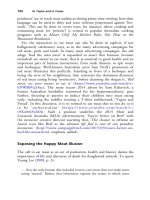The palgrave international handbook of a 217
Bạn đang xem bản rút gọn của tài liệu. Xem và tải ngay bản đầy đủ của tài liệu tại đây (39.21 KB, 1 trang )
212
A. Nurse
White (2007, p. 41) explains that ‘when it comes to environmental harm,
what actually gets criminalised by and large reflects an anthropocentric perspective on the nature of the harm in question’. The way in which environmental ‘rights’ are framed in law is determined by a range of strategic interests
(political, cultural and even the interests of industry) and depends on which of
a series of conflicting rights achieves prominence. School children are now
taught the value of wildlife and an environmentalist perspective, thus egg
collecting is no longer a socially condoned activity. Until recently hunting
with dogs (and in particular fox hunting) was also legal in the UK, demonstrating that while it may have been the subject of deeply polarised debate
between enthusiasts and opponents, what was considered to be deviant behaviour by one group of people was viewed as perfectly normal by another group.
Whether or not a person is considered to be deviant can, therefore, depend on
the legal and cultural conditions of a society. The social reaction to deviant
behaviour also differs from group to group, and evidence exists that anthropocentric notions of animals as property to be exploited are implicit if not
explicit in collecting activity. Collectors may, therefore, deny that their actions
are a crime explaining them away as legitimate use of natural resources or as an
‘error of judgement’ but not a criminal act. Matza (1964) developed drift
theory to explain how delinquents often accept a moral obligation to be bound
by the law but can drift in and out of delinquency. He suggested that people
live their lives fluctuating between total freedom and total restraint, drifting
from one extreme of behaviour to another. While they may accept the norms
of society they develop a special set of justifications for their behaviour which
allows them to justify behaviour that violates social norms. These techniques of
neutralisation (Eliason 2003; Sykes and Matza 1957) allow delinquents to
express guilt over their illegal acts but also to rationalise between those whom
they can victimise and those they cannot. This means that offenders are not
immune to the demands of conformity but can find a way to rationalise when
and where they should conform and when it may be acceptable to break the
law. As an example, for those offenders whose activities have only recently been
the subject of legislation, the legitimacy of the law itself may be questioned
allowing for unlawful activities to be justified. Many fox hunting enthusiasts,
for example, strongly opposed the (UK) Hunting Bill as being an unjust and
unnecessary interference with their existing activity and so their continued
hunting with dogs is seen as legitimate protest against an unjust law (The
Hunting Act 2004) and is denied as being criminal. Similarly egg collectors,
taxidermists and trophy hunters neutralise condemnation of their activities
citing the past legitimacy of the activity and the imposition of sanctions as
being the misguided preserve of urban elites.









